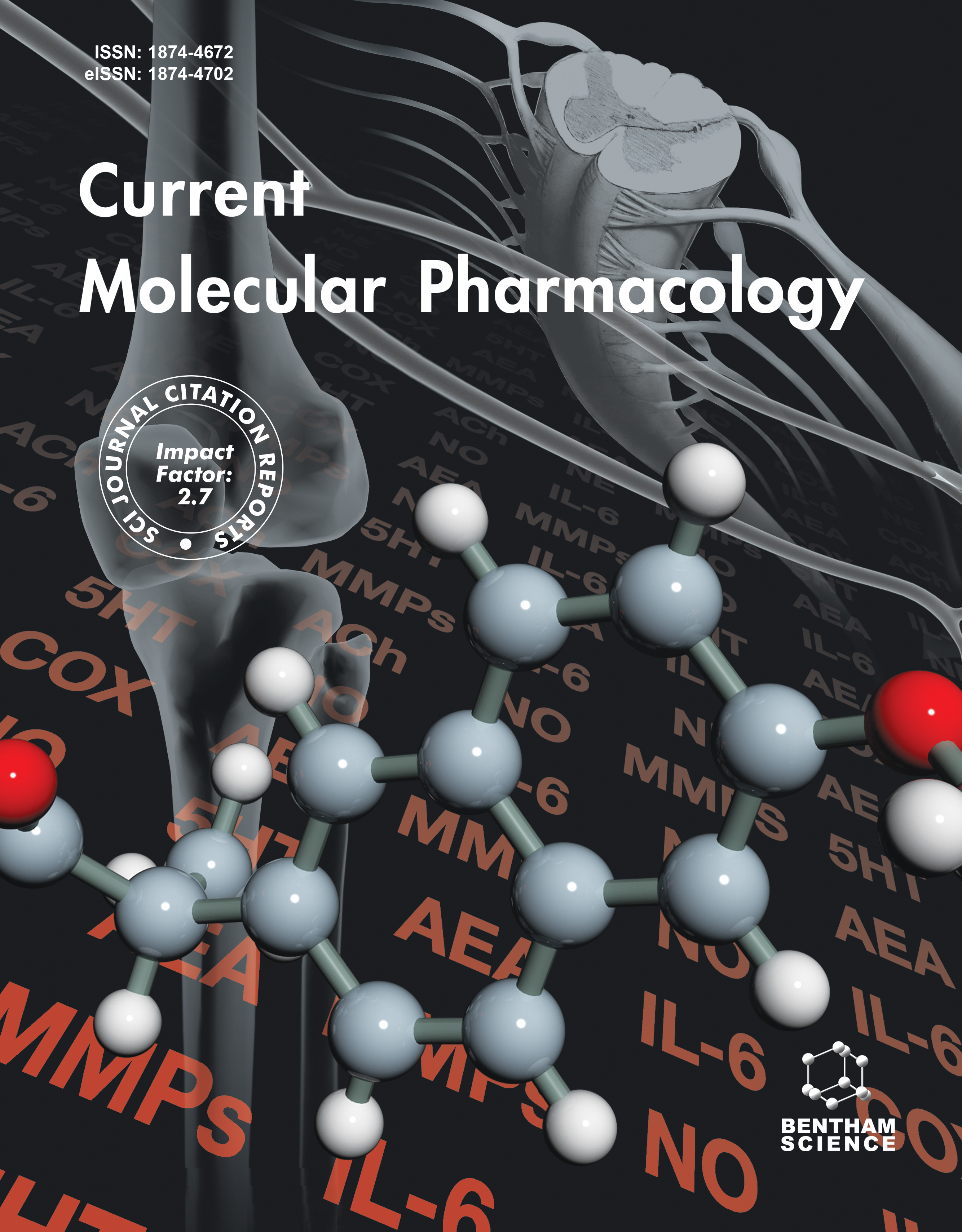- Home
- A-Z Publications
- Current Molecular Pharmacology
- Previous Issues
- Volume 10, Issue 4, 2017
Current Molecular Pharmacology - Volume 10, Issue 4, 2017
Volume 10, Issue 4, 2017
-
-
Milestones in CRH Research
More LessAuthors: George P. Chrousos and Emmanouil ZoumakisThe Corticotropin-releasing Hormone (CRH) mammalian family members include CRH, urocortin I, Stresscopin (SCP) and Stresscopin-related peptide (SRP), along with the CRH receptors type 1 (CRHR1) and type 2 (CRHR2), and CRH-binding protein (CRH-BP). These family members differ in their tissue distribution and pharmacology. Several studies have provided evidence supporting an important role of this family in the reg Read More
-
-
-
Prospective Clinical Applications of CRF Peptide Antagonists
More LessIt is noteworthy that thirty three years of efforts in corticotropin releasing factor (CRF) research by academia and the pharmaceutical industry resulted in several thousand papers and patents, yet little progress has been made to identify and market diagnostic or therapeutic CRF peptides and small molecule ligands. We document the potential relevance of CRF peptide antagonists to reinvigorate stress/anxiety affected “an Read More
-
-
-
Structure and Function of Small Non-Peptide CRF Antagonists and their Potential Clinical Use
More LessAuthors: Hesham Fahmy, Bhimanna Kuppast and Mohamed Teleb IsmailCorticotropin-releasing factor (CRF) can be considered a very important hormone or a chemical mediator. It works closely with other systems to regulate the manner through which the body may respond to stress. Thus it affects many biological processes associated with stress. Dysfunction of this system has also been correlated with various diseases such as major depression, anxiety, drug addiction and eating disorders. Ra Read More
-
-
-
Non-peptide CRF-Receptor Antagonists: Allosterism, Kinetics and Translation to Efficacy in Human Disease
More LessAuthors: Samuel R.J. Hoare and Dimitri E. GrigoriadisG-Protein coupled receptors (GPCRs) have been, and remain a key target of drug discovery programs for human disease. While many drugs have been developed that interact with these proteins in the simple classic manner - that is - physically blocking the cognate ligand from simply binding to its target receptor, drug discovery approaches have elucidated alternative more complex methods by which small molecules can inte Read More
-
-
-
CRH Receptor Signalling: Potential Roles in Pathophysiology
More LessAuthors: Dimitris K. Grammatopoulos and Styliani OurailidouTo maintain homeostatic equilibrium, living organisms have evolved complex adaptation systems that control an array of behavioural, autonomic, neuroendocrine and immune responses. One of the important switches of this system is the hypothalamic hormone corticotropin-releasing hormone (CRH), which together with a family of related peptides (urocortins, UCNs) orchestrate stress-coping responses that reinstate h Read More
-
-
-
Functional Significance of the Signal Peptides of Corticotropin-Releasing Factor Receptors
More LessAuthors: Ralf Schulein, Arthur Gibert and Claudia RutzThe corticotropin releasing factor (CRF) receptors belong to the large family of G proteincoupled receptors (GPCRs) and must be transported to the plasma membrane to function properly. The first step of the intracellular transport of GPCRs is their insertion into the membrane of the endoplasmic reticulum (ER). This process is mediated by the translocon complex of the ER membrane and the signal sequences of the r Read More
-
-
-
Structures of the First Extracellular Domain of CRF Receptors
More LessAuthors: Viviane Zelenay, Marilyn Perrin and Roland RiekCorticotropin releasing factor (CRF) receptors belong to the secretin family of G proteincoupled receptors (GPCRs) and are responsible for initiating endocrine stress responses and mediating anxiety related behaviors upon activation via stressors. The main binding site for the CRF ligands is the first extracellular domain (ECD) of the receptors. Several structures of ligand-free and ligand-bound ECDs were recently determined eith Read More
-
-
-
Understanding Corticotropin Releasing Factor Receptor (CRFR) Activation Using Structural Models
More LessAuthors: Arnau Cordomi, George Liapakis and Minos-Timotheos MatsoukasThe corticotropin-releasing factor type 1 and 2 receptors (CRF1R and CRF2R) belong to the secretin-like family, also known as class B1, of G protein-coupled receptors (GPCRs). Several endogenous hormones mediate their responses through the CRF receptors, such as CRF and the urocortins. The structures for the N-terminus extracellular domain of both CRF1R and CRF2R in complex with peptidic ligands were relea Read More
-
-
-
Decoding Corticotropin-Releasing Factor Receptor Type 1 Crystal Structures
More LessThe structural analysis of class B G protein-coupled receptors (GPCR), cell surface proteins responding to peptide hormones, has until recently been restricted to the extracellular domain (ECD). Corticotropin-releasing factor receptor type 1 (CRF1R) is a class B receptor mediating stress response and also considered a drug target for depression and anxiety. Here we report the crystal structure of the transmembrane domain of hu Read More
-
Most Read This Month
Article
content/journals/cmp
Journal
10
5
false
en


